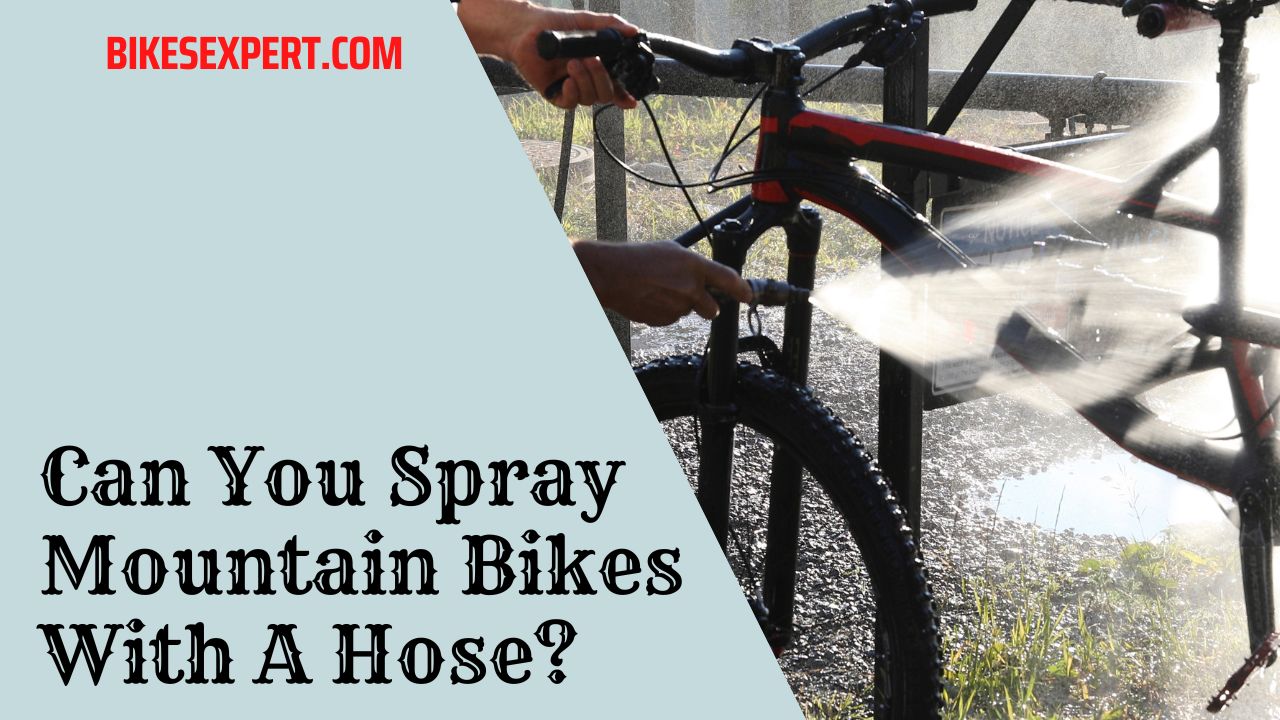Mountain bikes are for more than just riding in the dirt. Many people might use it on a paved surface, so hosing them down after riding is essential. Hose them off to keep grime and dust away!
To make your bike last longer, you should hose it down with water or take it to a car wash even if you don’t ride in the dirt all the time because there’s usually dirt from biking that can get onto your chain, and gears-housing will help prevent this!
When you’re done hosing off your mountain bike, dry it as best as possible by wiping down any dirty spots with a towel or rag, so they don’t rust over time!
If you don’t do this, your frame will rust, which means no good! Consider getting a bike cover, so the rain doesn’t get to it either. If your chain is still dirty after hosing off, consider wiping it down with some WD-40 or cooking spray!
Another post that will interest you is about MTB Nutrition: What To Eat Before, During, And After Your Ride?
Why Hosing Your Mountain Bike Is Important?
If you love riding your bike, keep it in good shape! Hosing down your mountain bike after riding is essential for a couple of reasons: to prevent the chain or gears from getting stuck with the dirt on them and to prevent rust from building up.
If your bike is not correctly maintained-then, it could get damaged more easily! Remember to wipe it down after riding.
After cleaning your bike to prevent rust or buildup of dirt, consider lubricating the chain, so it lasts longer! You can buy bicycle oil to help this problem out. Be careful not to get any lubricants on your bike’s paint-it could scratch off easily.
The reason why mountain bikes need to be cleaned so often is because of all that dirt that they pick up on their tires. After a long day of riding, the chain will be covered in dust and grime, which doesn’t do it any good-wiping it down with a rag is recommended.
Is It Safe To Spray With A Hose On A Mountain Bike?
Important Note: Spraying your bike with a hose will not damage it if done correctly, but you must ensure that the nozzle is of the correct pressure and that the water is cold – hot water can cause paint chips on the frame.
Please turn off the nozzle whenever you want to stop it from blasting on a specific area. Also, make sure that your bike is completely dry before riding it so that you don’t rust any metal components (this will depend on how dry your garden hose is!)
Hoses are excellent for cleaning off the dirt and mud accumulating on your mountain bike. They’re also good at getting into those hard-to-reach spaces, like between the wheel’s spokes or between the gears. But hoses tend to break up any dirt stuck to your bike, which can result in scratches and chips in your paint job.
If you don’t want scratches, you may need to find another way of washing off your bike. On the other hand, if minimizing scratches is not high on your list of priorities, then using a hose could be an effective way for you! To ensure this will work best for you with minimal damage, try out some light sections before going all in.
Before picking up a hose and spraying, ensure the water is cold. This will help to minimize any damage that can occur. It’s also good to have your bike on something solid, so it doesn’t get knocked over by the force of the water jetting out.
Depending on how much mud or dirt has built up, you may need to give your bike a quick wipe-down with a rag beforehand. Please hold the hose a fair distance from your bike while spraying down to avoid overspray and keep it moving!
How Do You Spray A Mountain Bike With A Hose?
- Hose down your bike from the top down, being careful not to spray components that could be damaged by water (like brake pads or derailleurs)
- Spray underneath your bike and the wheels, too-you want to drench your bike in water but not be left with a puddle on the garage floor.
- Do both sides of the bike to get it clean!
- Use an old rag to dry off excess moisture from moving parts.
- Let your bike sit out in the sun to dry.
How To Clean Your Mountain Bike Using A Garden Hose?
Step 1:
Check that the tires are deflated – if not, remove the valve core (a small silver cylinder in the center of the tire) and squeeze some air with your fingers into the lawn.
Step 2:
Please turn on the hose and ensure it is set to a high-pressure (cold water) setting.
Step 3:
Spray down your bike from top to bottom. Every time you pass an area, turn off the power switch on the nozzle so that you can get a better clean and thoroughly wash your areas of focus without damaging any areas of the bike you may want to save with a high-power blast.
Step 4:
In the end, spray down all metal components and allow them to run under cold water. Then you have washed your mountain bike!
Step 5:
Bonus tip: If you have cleaned it correctly, dust will remain on the painted surfaces where the water is rolled down. This is normal and will fall off after a ride or on its own.
Other Tips To Spray Mountain Bike With Hose:
- If you can, let your bike dry in the sun-this will help prevent rust and keep your frame looking good longer too!
- Do this every time after getting off your bike. This is a great way to ensure your gears are well-lubed and won’t stick or cause your chain to fall off on the trail!
- You can also clean your bike with dish soap and water-this is a great way to keep your drive train running smooth and clean of grime.
How To Wash A Mountain Bike?
Cleaning your bike is easier if you find a spacious place to do it. You can wash your cycle in your garden or at the local bike shop. For effective cleaning, you will also need the following items:
- Clean rags or clothes:
General cleaning and drying can be accomplished with them. As well as wiping grease or oil off the bike, you can also use them for cleaning.
- Brushes:
To remove dirt from surfaces, you need a variety of soft and firm brushes. Choosing bicycle parts with the right size and shape is essential for getting into hard-to-reach places.
- Water and a hosepipe:
Water will be used for rinsing, but you should avoid using a high-pressure hose. Your mountain bike’s bearings can be damaged by excessive pressure.
- Soap:
The frame needs to be cleaned with diluted soap. Washing a bike with any multipurpose soap or purchasing a preformulated bike cleaner is easy.
- Degreaser:
To remove grime from gummy parts, use a degreaser. Use an eco-friendly degreaser for your bike chain, and avoid turpentine.
- Cleaning a mountain bike is not the easiest thing to do, but it can be done with some effort and patience
- The first step in cleaning your bike is to remove any dirt or debris from the surface of the frame and components
- It would help if you used dish soap on anything that you cannot submerge in water, such as caliper brakes and shifters
- Use a soft cloth or sponge for this part of the process; steel wool or coarse brushes will scratch your bike’s paint job!
- Rinse everything off with fresh water before moving on to steps 6-8
- Remove all clogs from your brake pads by spraying them down with WD40 and then scrubbing them clean with a soft brush
- Spray WD40 on your chain and wash it until the gunk comes off, then rinse everything off again
- Apply a lubricant to the chain after removing all dirt is essential for better performance; this will keep the bike running smoothly and make cleaning more accessible in the future
Mountain Bike Frame
- Clean off any dirt on the bike’s surface with a soft brush or cloth
- Use an all-purpose cleaner like Simple Green to spray down your bike, and scrub it clean with an old toothbrush
- Rinse off the Simple Green, then apply Framesaver to prevent rust from forming in the future; you may have to repeat these steps several times to get rid of all the tiny scratches on your bike
- Wipe down the frame with a soft cloth after applying Framesaver to remove any excess oils
Mountain Bike Wheels
- Remove loose dirt from the rims, then blow them clean with compressed air
- Use an old toothbrush to scrub the rust spots on rims and brake pads
- Use WD40 or metal polish to remove rust, then dirt buildup from your brakes
- Spray chains with WD40, then spray it down with Simple Green cleaner and scrub off all grime using a solid brush
- Rinse everything off with a hose, then apply chain oil or Frame Saver to keep your bike running smoothly
Mountain Bike Derailleur and Shifter
- Spray WD40 on your derailleur pulleys, then scrub it clean using a toothbrush; you may need to repeat this step several times
- Use an old toothbrush or cotton swab to clean your shifter from dirt buildup; ensure the chain is off.
- Spray WD40 and scrub dirty parts using a toothbrush with abrasive bristles, then rinse everything off with water again
- Apply Framesaver or lubricant to make cleaning more accessible in the future
Mountain Bike Brakes and Calipers
- Spray caliper brakes with WD40 and scrub them clean with a toothbrush; you may need to repeat this step several times
- Use an old toothbrush or cotton swab to remove rust buildup from your brake pads, then spray it down with WD40
- Apply a lubricant to the brake pads and chain, then wipe everything down with a soft cloth
- Clean your rims before riding on them by spraying the brake fluid directly onto them and scrubbing clean; you may need to repeat this step several times until all dirt is removed
Mountain Bike DriveTrain
- Spray WD40 on your chain, then scrub it clean with a toothbrush
- Use an old toothbrush or cotton swab to remove dirt buildup from the shifter, derailleurs, and chainring
- Apply lubricant or Frame Saver to the drivetrain, including your crank arms, chainrings, and derailleurs
- Clean your bike’s frame by spraying the WD40 directly onto it and scrub everything clean; this will also remove any rust buildup on steel frames
- Rinse everything off with a hose, then wipe the frame down with a soft cloth to dry it entirely before riding
Mountain Bike Tires
- Spray WD40 on your tires and scrub them clean with a toothbrush, then rinse everything off with water to remove all dirt
- Apply lubricant or Frame Saver to the outside of your tires; this will protect them from getting damaged in the future, keeping you rolling down the trail as long as possible!
Mountain Bike Pedals
- Spray WD40 on your pedals and scrub them clean using a toothbrush
- Wipe the pedals down with a soft cloth or towel, then apply Framesaver to keep them from getting rusty!
Mountain Bike Saddle and Seatpost
- Spray the seat post with WD40 and scrub it clean using a toothbrush; you may need to repeat this step several times
- Apply lubricant or Frame Saver to the seat post and chainstays, protecting your bike from rust in the future
- Use an old toothbrush or cotton swab to remove dirt buildup from your saddle rails and seat post, then spray WD40 on it and scrub clean; you may need to repeat this step several times
- Use WD40 or metal polish to remove rust from your Seatpost clamp and saddle rails, then rinse away all dirt buildup with water
- Rinse everything off with a hose, then dry the frame before riding on it again!
Mountain Bike Seatpost, Seat, and Chainstays
- Spray lubricant or Frame Saver on the rails of your seat and chainstays
- Use an old toothbrush to remove dirt buildup from your saddle rails and Seatpost, then apply a lubricant or Frame Saver to them; this will keep them clean and rust-free
- Use a degreasing solution or laundry detergent and scrub your seat rails, then rinse everything off with water
- Apply Frame Saver or lubricant to the clamp of your seat post, saddle rails, and chainstays to protect them from getting dirty or rusty
- Spray WD40 into the holes of your seat post, then scrub it clean with a toothbrush; You may need to repeat this step several times
- Use WD40 or metal polish to remove rust from the holes of your seat post, rinse away all dirt buildup with water, and wipe everything down dry before riding again!
What Should You Do After Washing Your Bike?
When the parts have been cleaned and rinsed, use a rag or an air compressor to dry them off. Alternatively, you can bounce the bike to remove excess water and let it air dry in the sun. Lubricate the moving parts to ensure they run smoothly after scrubbing the grease drivetrain.
Ensure the entire length of the chain is coated with the lube that best suits your riding terrain. Wipe off any excess lubricant after allowing the lube to soak for a few minutes.
As a result of the extra lube, dirt can build up. It is essential to apply lube to the derailleur to prevent squeaking. Lubricate the chain after washing if it feels dry or begins to rust.
Putting silicone polish on the bike frame before riding in muddy terrain would be helpful if you want to protect the frame from water damage. It prevents mud from sticking to your bike. In dry landscapes, polish attracts dust.
Conclusion:
The right mountain bike cleaning products and tools can keep your bike looking new. We’ve provided a step-by-step guide on how to clean each part of your bike, so you can keep it running smoothly for years to come!
Do you have any mountain bike cleaning tips or tricks of your own? Leave us a comment below, and we’ll add them to the article!
Read More: Putting Stunt Pegs On A Mountain Bike? (Explained For Beginners).




